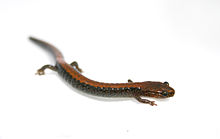- Red Back Salamander
-
red back salamander 
Conservation status Scientific classification Kingdom: Animalia Phylum: Chordata Class: Amphibia Order: Caudata Family: Plethodontidae Genus: Plethodon Species: P. cinereus Binomial name Plethodon cinereus
(Green, 1818)Synonyms Salamandra cinerea Green, 1818
The red back (or redback or red-backed) salamander (Plethodon cinereus) is a small, hardy woodland salamander. It inhabits wooded slopes in Eastern North America; west to Missouri; south to North Carolina; and north from southern Quebec and the Maritime Provinces in Canada to Minnesota. It is also known as the Northern redback salamander to distinguish it from the Southern redback salamander (Plethodon serratus). The red-backed salamander is found mostly in two color variations: the nominate red variety, 'redback', as well as a darker phase known as the 'leadback' which lacks most or all of the red pigmentation found in the red phase.[1] However, one can also find a variety of other color variations (e.g., stripe of yellow, orange, white, or an uncommon erythristic morph, which is completely reddish-orange).
Contents
Reproduction and biomass
Males and females typically establish separate feeding and/or mating territories underneath rocks and logs. However, some red back salamanders are thought to engage in social monogamy, and may maintain co-defended territories throughout their active period. Breeding occurs in June and July. Females produce from 4–17 eggs in a year. The eggs will hatch in 6–8 weeks. Not much is known about the dispersal of neonates, although it is thought that neonates and juveniles are philopatric. The species largely consumes invertebrates and other detritus dwellers. In some areas with good habitat, these salamanders are so numerous that their population densities may surpas 1,000 individuals per acre.[2]
Captivity
Red back salamanders are very popular pets because of their hardiness. Cages do not need to be exceptionally large, and a common sweater box may be used with small holes poked on the sides. This can be done by using a hot pin. The enclosure must have a secure lid, for red back salamanders are able to climb on smooth surfaces. They require driftwood and some sort of ground cover in them to keep the salamander feeling secure. The environment must be partially moist and kept out of direct sunlight or the salamander's skin will dry out and it will suffocate. Too much water can cause stress especially when it forms pools (salamanders can swim but hate it because of the lack of oxygen present in water and will drown if they cannot escape).
Ideal temperature for them would be 58 to 65 °F (14 to 18 °C), if it gets over 75 °F (24 °C) the salamander will either dry out and suffocate, or burrow very deeply. If the temperature reaches anywhere from 35–50 °F (2–10 °C) they will start to hibernate and anywhere below freezing they will die if they are not underground. Staple diets consist of small black or red ants, small spiders, pinhead crickets, chopped earthworms, small mealworms[3] or even other salamanders. One should be cautious when putting two red back salamanders that were not found together in a small container with little food; as they are canibalistic, they may eat their own eggs and hatchlings.
References
- ^ Animal Diversity Web
- ^ APPALACHIAN NATURE: An Entree’ of Salamanders
- ^ Caudata
External links
 Data related to Plethodon cinereus at Wikispecies
Data related to Plethodon cinereus at Wikispecies- Plethodon cinereus
- Parental Care in Plethodon cinereus
- Plethodon cinereus, Caudata Culture
- Eastern Redback Salamander (Plethodon cinereus), Natural Resources Canada
- The identification of 2,4-diacetylphloroglucinol as an antifungal metabolite produced by cutaneous bacteria of the salamander Plethodon cinereus
Categories:- IUCN Red List least concern species
- Plethodon
- Woodland salamanders
- Amphibians of Canada
- Amphibians of the United States
- Fauna of the Eastern United States
- Fauna of Delaware and Maryland
- Animals described in 1818
Wikimedia Foundation. 2010.

